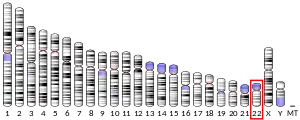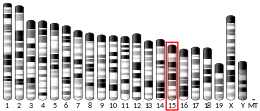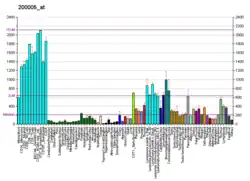EIF3D
Eukaryotic translation initiation factor 3 subunit D (eIF3d) is a protein that in humans is encoded by the EIF3D gene.[5][6]
Function
Eukaryotic translation initiation factor-3 (eIF3), the largest of the eIFs, is a multiprotein complex composed of at least ten nonidentical subunits. The complex binds to the 40S ribosome and helps maintain the 40S and 60S ribosomal subunits in a dissociated state. It is also thought to play a role in the formation of the 40S initiation complex by interacting with the ternary complex of eIF2/GTP/methionyl-tRNA, and by promoting mRNA binding. The protein encoded by this gene is the major RNA binding subunit of the eIF3 complex.[6]
Interactions
EIF3D has been shown to interact with PHLDA1[7] and EIF3A.[8][9][10]
EIF3D has also been shown to interact with c-Jun mRNA via a non-canonical mechanism. Instead of the EIF4G protein acting as a cap-binding protein to mediate translation, EIF3D has been shown to be a cap binding protein for certain mRNAs such as c-Jun which has structures at the 5' UTR inhibiting binding of EIF4G and promoting binding of EIF3D.[11] EIF3D as a cap binding protein has been thought of as critical to regulating gene expression under cell stress such as during glucose deprivation. For translation of c-Jun under glucose starved conditions, the cap binding activity of EIF3D increased by 10-fold.[12][13]
References
- GRCh38: Ensembl release 89: ENSG00000100353 - Ensembl, May 2017
- GRCm38: Ensembl release 89: ENSMUSG00000016554 - Ensembl, May 2017
- "Human PubMed Reference:". National Center for Biotechnology Information, U.S. National Library of Medicine.
- "Mouse PubMed Reference:". National Center for Biotechnology Information, U.S. National Library of Medicine.
- Asano K, Vornlocher HP, Richter-Cook NJ, Merrick WC, Hinnebusch AG, Hershey JW (October 1997). "Structure of cDNAs encoding human eukaryotic initiation factor 3 subunits. Possible roles in RNA binding and macromolecular assembly". The Journal of Biological Chemistry. 272 (43): 27042–27052. doi:10.1074/jbc.272.43.27042. PMID 9341143.
- "Entrez Gene: EIF3S7 eukaryotic translation initiation factor 3, subunit 7 zeta, 66/67kDa".
- Hinz T, Flindt S, Marx A, Janssen O, Kabelitz D (May 2001). "Inhibition of protein synthesis by the T cell receptor-inducible human TDAG51 gene product". Cellular Signalling. 13 (5): 345–352. doi:10.1016/S0898-6568(01)00141-3. PMID 11369516.
- Ewing RM, Chu P, Elisma F, Li H, Taylor P, Climie S, et al. (2007). "Large-scale mapping of human protein-protein interactions by mass spectrometry". Molecular Systems Biology. 3 (1): 89. doi:10.1038/msb4100134. PMC 1847948. PMID 17353931.
- Mayeur GL, Fraser CS, Peiretti F, Block KL, Hershey JW (October 2003). "Characterization of eIF3k: a newly discovered subunit of mammalian translation initiation factor elF3". European Journal of Biochemistry. 270 (20): 4133–4139. doi:10.1046/j.1432-1033.2003.03807.x. PMID 14519125.
- Block KL, Vornlocher HP, Hershey JW (November 1998). "Characterization of cDNAs encoding the p44 and p35 subunits of human translation initiation factor eIF3". The Journal of Biological Chemistry. 273 (48): 31901–31908. doi:10.1074/jbc.273.48.31901. PMID 9822659.
- Lee AS, Kranzusch PJ, Doudna JA, Cate JH (August 2016). "eIF3d is an mRNA cap-binding protein that is required for specialized translation initiation". Nature. 536 (7614): 96–99. Bibcode:2016Natur.536...96L. doi:10.1038/nature18954. PMC 5003174. PMID 27462815.
- Jia L, Qian SB (January 2021). "A Versatile eIF3d in Translational Control of Stress Adaptation". Molecular Cell. 81 (1): 10–12. doi:10.1016/j.molcel.2020.12.016. PMID 33417853. S2CID 231303797.
- Lamper AM, Fleming RH, Ladd KM, Lee AS (November 2020). "A phosphorylation-regulated eIF3d translation switch mediates cellular adaptation to metabolic stress". Science. 370 (6518): 853–856. Bibcode:2020Sci...370..853L. doi:10.1126/science.abb0993. PMID 33184215. S2CID 226308112.
Further reading
- Asano K, Kinzy TG, Merrick WC, Hershey JW (January 1997). "Conservation and diversity of eukaryotic translation initiation factor eIF3". The Journal of Biological Chemistry. 272 (2): 1101–1109. doi:10.1074/jbc.272.2.1101. PMID 8995409.
- Méthot N, Rom E, Olsen H, Sonenberg N (January 1997). "The human homologue of the yeast Prt1 protein is an integral part of the eukaryotic initiation factor 3 complex and interacts with p170". The Journal of Biological Chemistry. 272 (2): 1110–1116. doi:10.1074/jbc.272.2.1110. PMID 8995410.
- Block KL, Vornlocher HP, Hershey JW (November 1998). "Characterization of cDNAs encoding the p44 and p35 subunits of human translation initiation factor eIF3". The Journal of Biological Chemistry. 273 (48): 31901–31908. doi:10.1074/jbc.273.48.31901. PMID 9822659.
- Dunham I, Shimizu N, Roe BA, Chissoe S, Hunt AR, Collins JE, et al. (December 1999). "The DNA sequence of human chromosome 22". Nature. 402 (6761): 489–495. Bibcode:1999Natur.402..489D. doi:10.1038/990031. PMID 10591208.
- Asano K, Shalev A, Phan L, Nielsen K, Clayton J, Valásek L, et al. (May 2001). "Multiple roles for the C-terminal domain of eIF5 in translation initiation complex assembly and GTPase activation". The EMBO Journal. 20 (9): 2326–2337. doi:10.1093/emboj/20.9.2326. PMC 125443. PMID 11331597.
- Hinz T, Flindt S, Marx A, Janssen O, Kabelitz D (May 2001). "Inhibition of protein synthesis by the T cell receptor-inducible human TDAG51 gene product". Cellular Signalling. 13 (5): 345–352. doi:10.1016/S0898-6568(01)00141-3. PMID 11369516.
- Morris-Desbois C, Réty S, Ferro M, Garin J, Jalinot P (December 2001). "The human protein HSPC021 interacts with Int-6 and is associated with eukaryotic translation initiation factor 3". The Journal of Biological Chemistry. 276 (49): 45988–45995. doi:10.1074/jbc.M104966200. PMID 11590142.
- Mayeur GL, Fraser CS, Peiretti F, Block KL, Hershey JW (October 2003). "Characterization of eIF3k: a newly discovered subunit of mammalian translation initiation factor elF3". European Journal of Biochemistry. 270 (20): 4133–4139. doi:10.1046/j.1432-1033.2003.03807.x. PMID 14519125.
- Collins JE, Wright CL, Edwards CA, Davis MP, Grinham JA, Cole CG, et al. (2004). "A genome annotation-driven approach to cloning the human ORFeome". Genome Biology. 5 (10): R84. doi:10.1186/gb-2004-5-10-r84. PMC 545604. PMID 15461802.
- Rush J, Moritz A, Lee KA, Guo A, Goss VL, Spek EJ, et al. (January 2005). "Immunoaffinity profiling of tyrosine phosphorylation in cancer cells". Nature Biotechnology. 23 (1): 94–101. doi:10.1038/nbt1046. PMID 15592455. S2CID 7200157.
- Ewing RM, Chu P, Elisma F, Li H, Taylor P, Climie S, et al. (2007). "Large-scale mapping of human protein-protein interactions by mass spectrometry". Molecular Systems Biology. 3 (1): 89. doi:10.1038/msb4100134. PMC 1847948. PMID 17353931.




